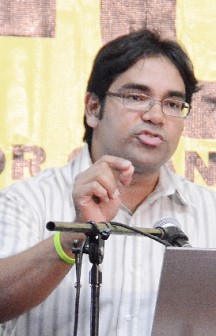Constructing the Amaila Falls hydropower plant at a cost of US$835 million will not reduce the cost consumers have to pay for electricity and may not be the answer to the country’s energy needs, the AFC’s economic advisor Dr Tarron Khemraj says.
“Given the demand for electricity in Guyana right now, if they build a hydro for US$835 million, you guys get ready for some very expensive electricity,” Dr Khemraj warned yesterday while delivering a lecture at the Pegasus Hotel. The lecture, titled ‘From Under-Performance to Economic Transformation,’ sought to present the AFC’s economic vision for Guyana and Khemraj put forward a plan consisting of several small hydropower plants and other forms of renewable sources of energy such as ethanol and bagasse.

Dr Khemraj, a professor at the Florida State University, likened the construction of the Amaila Falls hydropower station at such a high cost to the construction of the Berbice Bridge, while noting that the bridge toll is too costly for the average citizen simply because the government has set a rate necessary to recover its initial investment.
The escalation in the project cost of the Amaila Falls hydropower plant was recently announced by President Bharrat Jagdeo. Yesterday Sithe Global, the developer for the project, said that the new price was based on the final Engineering, Procure-ment and Construction (EPC) price from the project contractor China Railway, and reflected the significant increase in key commodities for the project and the appreciation of the Chinese Yuan by nearly 8 per cent. It also maintained that the project is still the best “low-cost, long-term” option to reduce power costs.
Khemraj told Stabroek News that the unit price for electricity will not be reduced following the construction of the Amaila Falls plant. “The unit price at which it will sell at is a fixed cost so you have to divide that fixed cost plus the interest cost… by the demand… and if you do that the unit cost is going to be just as expensive as what we have now,” he said. According to him, Guyanese will have to bear this financial strain for 20 years until the loans for the project are repaid.
He said that should the AFC assume office, it would reconsider the project. “I don’t see it happening, not at that price. If I’m the planner why would I burden our producers more?” he said. He emphasised that the party was not against hydropower but said that it has a comprehensive renewable energy strategy for many sources. Khemraj said that personally he felt a hydropower plant at Tiger Falls may be more feasible but this still has to be discussed at the party level.
‘Lowest cost
option’
Meanwhile, Sithe Global last evening said that the US$835 million price tag, based on the final EPC price from China Railway, includes all associated financing costs, non-EPC construction costs and project development costs.
The new project cost, Sithe said in a release, is based on a new EPC price of US$508 million, up 18 per cent from the price in 2009. The increased price, it noted, requires more debt financing to be secured for the project. This results in higher costs for interest during construction and political risk insurance. “Certain non-EPC costs have increased as well,” the release added.
Sithe said that the new price put forward by China Railway reflected a very significant impact caused by increased commodity prices, changes resulting from engineering work /site reconnaissance and the appreciation of the Chinese Yuan.
According to Sithe, the appreciation of the Chinese Yuan by nearly 8 per cent was the single largest factor in the proposed price increase. It pointed too to the increased price of key commodities, such as copper (which has increased by nearly 50 per cent from the original bid), steel (up 35 per cent) and crude oil, noting that play a significant role in the EPC price increase. Sithe said too that the quantities of materials required to build the facility were also adjusted as the required pre-construction site reconnaissance work was completed.
Now that the parties have agreed on the EPC contract, China Railway will accept the risk of further price escalation as of the commencement of the construction.
China Railway, the developers said, won the contract for the project in 2009, after submitting the lowest of four bids for the hydropower project. According to Sithe, the company submitted a bid of US$430 million for the construction of the transmission line and hydroelectric plant. The total cost was estimated at up to US$700 million, it said.
“The project remains fundamentally strong because it is the lowest cost option for Guyana Power & Light (GPL),” Sithe said, adding that while everything possible is being done to minimise the cost of the project, it “continues to represent the best low-cost, long-term option to reduce GPL’s average generation costs and dependency on imported fossil fuels.
“Furthermore, it entails significant improvement of the electricity infrastructure in Guyana that will support Guyana’s overall economic growth and sustainable development, based on a reliable, affordable electricity grid for its industries, businesses and residents.”
Sithe said that so far it has spent over US$10 million on third party environmental, technical and legal costs associated with the development of the project. According to the company, it intends to contribute in excess of US$200 million of equity funding during the construction.
The Amaila Falls hydropower project is expected to be a 165 MW facility at the Amaila and Kuribrong rivers.





